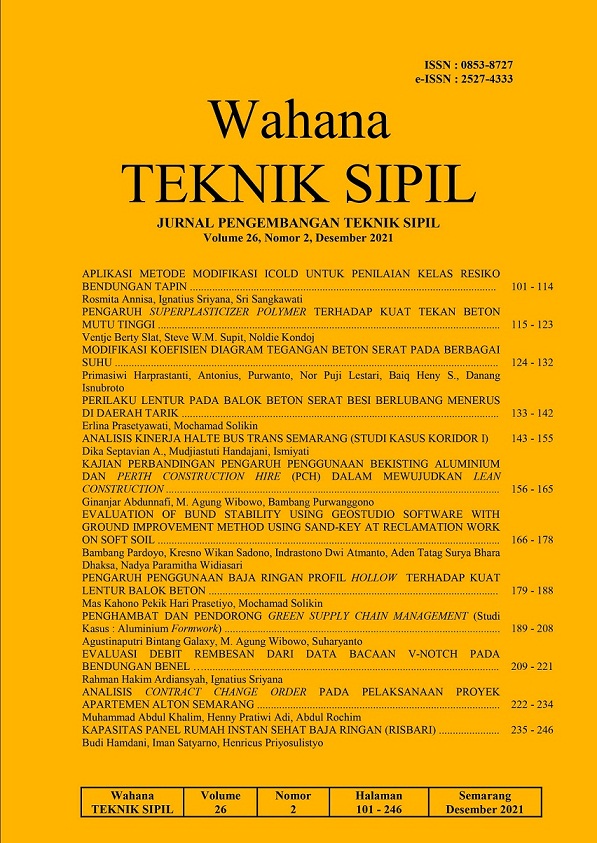ANALISIS CONTRACT CHANGE ORDER PADA PELAKSANAAN PROYEK APARTEMEN ALTON SEMARANG
DOI:
https://doi.org/10.32497/wahanats.v26i2.3135Keywords:
change order, causative factor, impact, strategyAbstract
A contract change order (CCO) is a job change activity in a construction project that is carried out during the work implementation period. This study aims to determine the factors that cause contract change orders, analyze the impact given if there is a contract change order and analyze what strategies must be done to resolve the occurrence of contract change orders in the implementation of the Alton Apartment building construction project located in the city of Semarang. The data collected in this study used a semi-structured interview method with competent sources in their field, while the sources for data collection were construction management consultants (MK), contractors & owners. The Strength, Weakness, Opportunity, Threats (SWOT) analysis method is used to determine the right strategy to deal with CCO activities. The conclusion of the study, CCO was caused by an imperfect design that resulted in the achievement of time and costs not being on target, the strategy was obtained by accelerating work, controlling each work and project cashflow and referring back to the wholesale contract that was mutually agreed upon in the event of a dispute.References
Alaryan, A., Emadelbeltagi, Elshahat, A., and Dawood, M. 2014, Causes and Effects of Change Order on Construction Project in Kuwait. International Jurnal of Engineering Research and Applications, 4 (7): 1-8.
Aziz, R.F., 2013, Ranking of delay factors in construction projects after Egyptian revolution. Alexandria Engineering Journal, 52 (3): 387-406.
Desai, J.N., Pitroda, J. and Bhavsar, J. J. 2015, A Review On Change Order and Assessing causes Affecting Change Order In Construction. Journal of International Academic Research for 2 (12): 152-162.
Ghumolili, S.A., Sompie. B.F., and Rantung, J.P. 2012, Analisa Faktor-faktor Penyebab Change Order dan Pengaruhnya Terhadap Kinerja Waktu Pelaksanaan Proyek Konstruksi di Lingkungan Pemerintah Provinsi Sulawesi Utara. Jurnal Ilmiah Media Engineering, 2 (4): 247-256.
Maulana, A., 2016, Faktor-faktor Penyebab Terjadinya Contract Change Order (CCO) dan Pengaruhnya Terhadap Pelaksanaan Proyek Konstruksi Pembangunan Bendung. Jurnal Infrastruktur. 2 (2): 40-51.
Gokulkarthi, M., 2015, A Study On Impacts Of Change Order In Construction Projects. International Jurnal of Science and Engineering Research (IJOSER), 3 (4): 1-6.
Ningsih, Syahrudin, dan Wardhani, N. 2015, Identifikasi dan Analisis Penyebab dan Akibat Contract Change Order Terhadap Biaya dan Waktu Pada Proyek Konstruksi. Jurnal PWK, Laut, Sipil, Tambang. 2 (2): 1-6.
Widhiawati, I.A.R., Wiranata, A.A., dan Wirawan, I.P.Y., 2016, Faktor-faktor Penyebab Change Order Pada Proyek Konstruksi Gedung. Jurnal Ilmiah Teknik Sipil, A Scientific Jurnal Of Civil Engineering, 20 (1): 1-7.
Yana, A.A. Gde, Agung, H.A., Rusdhi, Wibowo, M. Agung, 2015, Analysis of Factors Affecting Design Change in Construction Project With Partial Least Square (PLS). Procedia Engineering, Vol. 125 Hal 40-45.
Zulqarnain, 2017, Analisa Faktor Penyebab dan Akibat Change Order Terhadap Biaya dan Waktu Pada Proyek Konstruksi Jalan di Sulawesi Selatan. Tugas Akhir. Universitas Hasanuddin, Makassar.
Downloads
Published
Issue
Section
License
Authors who publish with this journal agree to the following terms:Authors retain copyright and grant the journal right of first publication with the work simultaneously licensed under a Creative Commons Attribution License that allows others to share the work with an acknowledgement of the work's authorship and initial publication in this journal.
Authors are able to enter into separate, additional contractual arrangements for the non-exclusive distribution of the journal's published version of the work (e.g., post it to an institutional repository or publish it in a book), with an acknowledgement of its initial publication in this journal.
Authors are permitted and encouraged to post their work online (e.g., in institutional repositories or on their website) prior to and during the submission process, as it can lead to productive exchanges, as well as earlier and greater citation of published work (See The Effect of Open Access).






